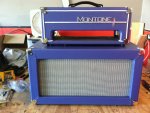famous beagle
Well-known member
Hey y'all,
So I'm almost finished building my Marshall 18-watt clone amp (see pictures), and I'm ready to wire the speaker cabinet. I have two 10" Weber speakers rated at 8 ohms each. The amp head has selectable impedance of 4, 8, or 16 ohms.
I'm curious if there are big sonic differences in wiring series (16 ohms) or parallel (4 ohms). I don't have any personal experience with this, and I'm wondering if anyone else has.
Thanks!
So I'm almost finished building my Marshall 18-watt clone amp (see pictures), and I'm ready to wire the speaker cabinet. I have two 10" Weber speakers rated at 8 ohms each. The amp head has selectable impedance of 4, 8, or 16 ohms.
I'm curious if there are big sonic differences in wiring series (16 ohms) or parallel (4 ohms). I don't have any personal experience with this, and I'm wondering if anyone else has.
Thanks!


